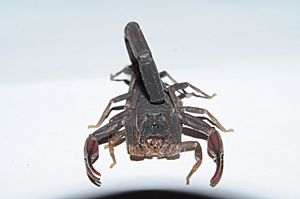Centruroides gracilis facts for kids
Quick facts for kids Centruroides gracilis |
|
|---|---|
 |
|
| Scientific classification |
The Centruroides gracilis is a type of scorpion that belongs to the family called Buthidae. These are often known as bark scorpions. People also call this scorpion the Florida bark scorpion, brown bark scorpion, or slender brown scorpion. In Cuba, it has special names like alacran prieto (which means "dusky scorpion") and alacran azul ("blue scorpion").
Even though one of its names is "Florida bark scorpion," it actually did not come from Florida in the United States. This scorpion is originally from the northern parts of Central America. This includes countries like Mexico, Guatemala, Belize, and Honduras. It has also been brought to other places by people. These places include Cuba, Panama, Colombia, Ecuador, Jamaica, and Florida. You can also find it in parts of Africa, like Cameroon and Gabon, and on the Canary Islands.
In Florida, this scorpion lives in the same areas as two other native scorpions. These are the Hentz striped scorpion and the Guiana striped scorpion. Sometimes, people even keep the Centruroides gracilis as a pet.
Contents
What It Looks Like
Female scorpions of this kind can grow up to 10 centimeters long. Males can grow even bigger, sometimes more than 15 centimeters. Their color can be different from one scorpion to another. Sometimes, scorpions of different colors are born in the same group. They might be reddish, or black with reddish claws (called chelae). Some are dark brown with yellowish legs and red claws. Others are dark brown with reddish and black parts on their tail.
Life Cycle
A female scorpion usually gives birth to 25 to 35 baby scorpions at one time. But sometimes, a mother can have as many as 91 babies! When they are very young, the baby scorpions ride on their mother's back. They shed their skin for the first time when they are about eight days old.
Scientists have studied how long these scorpions live and grow. Young scorpions go through different growth stages. They shed their skin several times as they get bigger. Sometimes, they can have problems when they are shedding their skin and might not survive.
Female scorpions usually become adults in about 300 days. They shed their skin seven times before they are fully grown. Male scorpions grow up at different speeds. Some males become adults when they are about 235 days old, after shedding their skin six times. Other males might not be adults until they are around 281 days old, after seven skin sheds.
When scorpions mate, the male performs a special courtship dance. Females can also have babies without a male, which is a special process called parthenogenesis. In a lab, male scorpions lived for about 33 months on average. Female scorpions lived a bit longer, about 38 months.
What It Eats
This scorpion likes to eat insects. It often hunts roaches. If you keep these scorpions as pets, you can feed them termites or crickets.
Where It Lives
The Centruroides gracilis scorpion often lives under rocks and under the bark of trees. If it finds a good spot, it might also live inside the walls of houses. You can sometimes find them under piles of rubbish in yards too.
Who Hunts It
Some animals hunt this scorpion. One of its predators is the tarantula, like the Tliltocatl vagans spider. A tarantula can kill the scorpion, even if the scorpion tries to attack first.
About Its Venom
This scorpion has venom, but it is not as strong as the venom of some other scorpions in its group. When it stings, the venom can cause some effects in the body.
If you get stung, the area might feel painful, turn red, itch, and swell up. The venom can also affect the heart, causing it to beat unusually fast or slow. Other possible symptoms include feeling sick to your stomach, throwing up, sweating a lot, or having diarrhea. In very rare cases, a sting could lead to serious problems.
See also
 In Spanish: Alacrán prieto para niños
In Spanish: Alacrán prieto para niños

